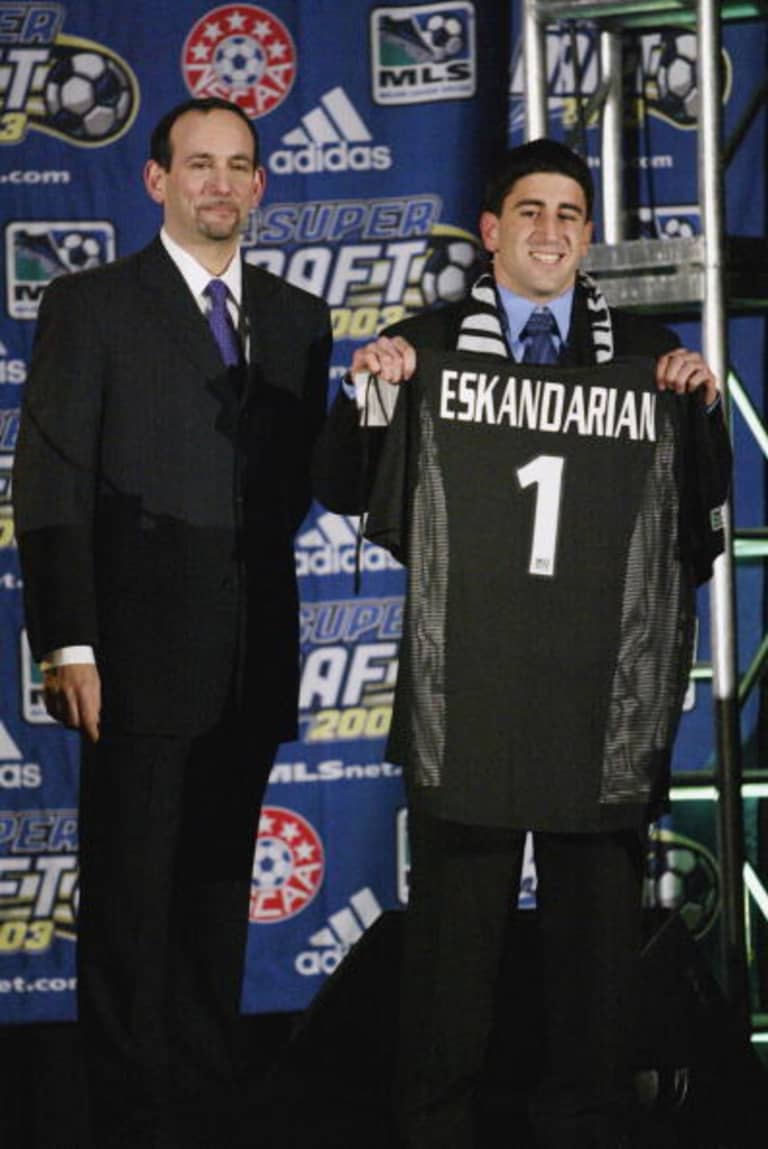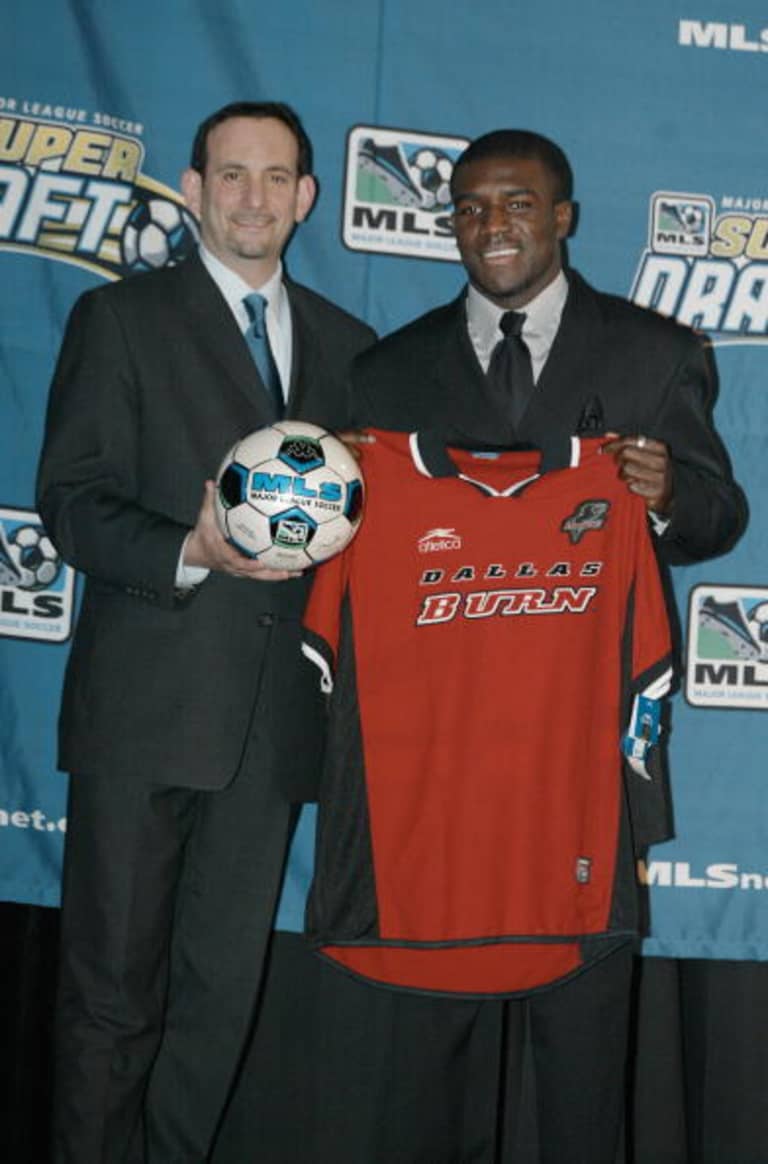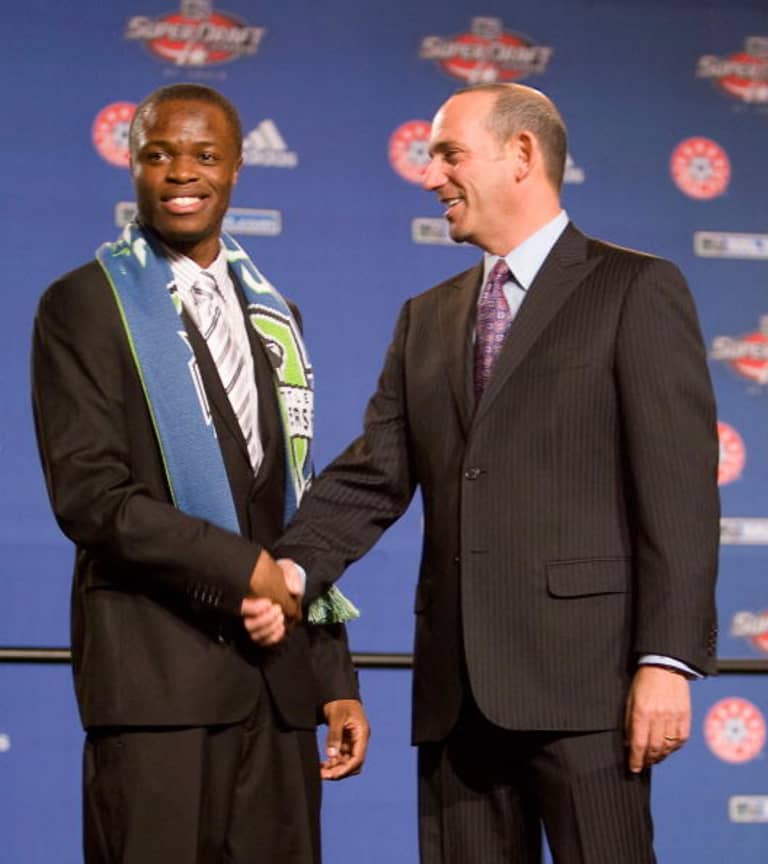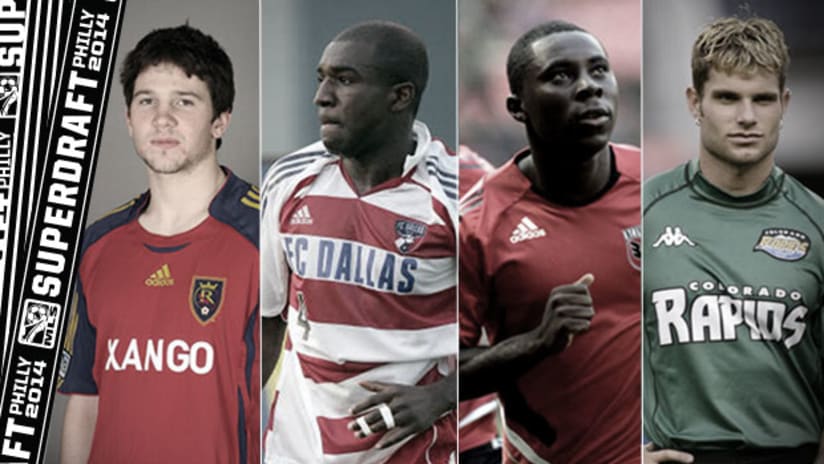Ask around to those who were working the phones in Major League Soccer in 2003 and there’s little doubt that Alecko Eskandarian was as much of a sure-fire star in the making as any team could get.
The draft class was loaded with future stars that year – Ricardo Clark, Mike Magee, Todd Dunivant and Pat Noonan all forged careers after being selected in the first round – but few could match the pedigree of Eskandarian (right), a three-time All-American at Virginia who was simply the best college player in the country at 20 years old.
But for all his accolades, the media that swallowed him up at the SuperDraft in Kansas City wouldn’t budge an inch. What they wanted to know, he still recalls more than a decade after he was taken first overall by D.C. United, was if he could somehow break the curse.
“That’s all they wanted to talk about, for the first 10 minutes of talking to me,” he said. “Right off the bat, I knew there was a stigma about it.”

As the nation’s top young players jockey to be called onto the podium at the SuperDraft on Thursday in Philadelphia (noon ET, ESPNEWS), the question somehow still lingers. Considering all the false starts, injuries and career blowouts that have hounded the top picks in years past, is there still a curse on No. 1?
Of course it’s not really that simple – or that silly – but history certainly shows that top picks struggle to carve out stable careers as much or more so than any other slot in the draft. Of the 14 players taken since the first SuperDraft in 2000, the hits – Eskandarian, Maurice Edu, Marvell Wynne, Chance Myers – certainly pale to the enormity of the misses, even with the verdict graciously still out on some of the youngsters taken since the league’s expansion era began in 2009.
Where did it go wrong? First, the obvious factor. The top picks traditionally join the worst team from the season before or, in an even tougher scenario, an expansion franchise building from the ground up. Neither is an easy draw.
This year it’s a case of the former, with D.C. United holding the spot after the hands-down worst season of any team in league history. Head coach Ben Olsen’s side actually isn’t as rough as other last-place clubs in years past, but they’ll still be on the lookout for an impact player in Year 1.
“You know you’re going to bad team, but often times they expect you to be a franchise guy,” said Chris Gbandi, taken first overall to Dallas in 2002. “Being No. 1 – the savior, the guy who will all of a sudden turn a franchise around – just adds to all the reasons why some of the guys just haven’t panned out.”’
For the record, Gbandi (below, right) was one of the good ones, compared to some of the others taken first overall. He forged an admirable career with Dallas and later with Norwegian side FK Haugesand and now coaches at the College of Holy Cross, but Gbandi will likely live longer in infamy as the man taken one spot ahead of Taylor Twellman.
There’s a similar sentiment for Steve Shak, taken first overall in 2000 by the New York MetroStars. A former walk-on defender at UCLA, he was a bit surprised when his name was called instead of some of his higher-profile teammates, future US national team captain Carlos Bocanegra chief among them.
Shak appeared in 23 games as a rookie on a talented MetroStars team, but then never really found traction in the years that followed. He was out of the league by 2002.

Now an assistant coach with the USL PRO’s Charlotte Eagles, Shak says it took years just to talk about the disappointment of his stunted career, and that for a lengthy period of time he felt ashamed he never lived up to the hype of being the top pick.
“I wasn’t mentally strong enough at that point in my life to be able to carry some of the expectations that I put on myself,” he says. “I wasn’t a bad player, but I didn’t perform up to my capabilities, for whatever reason or any number of reasons. But I can’t blame it on the No. 1 pick.”
There are other cautionary tales – Chris Carrieri in 2001, teenager Nik Besagno in 2005 and, depending on your opinion of his tumultuous career so far, Freddy Adu in 2004 – and some stories still yet to be written. Of the five players drafted first overall since 2009, one suffered a frightful broken leg that at least temporarily halted his career (Steve Zakuani), another has been traded twice and had his option declined last year (Danny Mwanga) and a third has appeared in just seven regular season games over the past two seasons (Omar Salgado).
Philadelphia Union CEO Nick Sakiewicz has one theory why it’s been a rough road for top picks: There’s too much hype for a player who might not actually be much better than the other guys in the draft.
“The top 20 players are all very good players, but they’re all raw,” says Sakiewicz who, as the MetroStars GM, took Shak in 2000 and later drafted Mwanga in Philadelphia in 2010. “They’re all inexperienced. They’re all projects. I’ve come to find out that there is a lot of undue hype surrounding the No. 1 pick because there’s very little difference between No. 1 and No. 20, in terms of the quality of the players.”
History bares that theory out. A quick look at the draft indicates that any number of other slots in the draft have produced just as much productivity as No. 1, with no better place to start than the second pick. That’s where the likes of Clark, Twellman, Chad Marshall, Brad Guzan, Brek Shea and Darlington Nagbe all landed, spurned for one reason or another by a club who may have regretted the choice ever since.
Or how about the third pick? Two players who could feature in the World Cup this summer – Brad Davis and Omar Gonzalez – fell this far, as well as MLS regulars Tony Beltran, Perry Kitchen and Kelyn Rowe.
No. 4? Magee, Bocanegra, Ryan Nelsen and Sean Franklin. There’s even a better record at No. 6, the spot where Dunivant, Danny Califf, Drew Moor, Dax McCarty, Amobi Okugo and Deshorn Brown all landed.
So yes, there’s talent for the taking well beyond the first pick. And in many cases – as MLS teams become more savvy building their teams via other means and begin using the draft to simply plug holes in the lineup – the top pick is just the best player in a position the team needs to fill.

“What people don’t understand is that some teams will use the No. 1 pick on the best player in the class, but a lot of times they’ll just take what they need,” said Zakuani (right), taken first overall to Seattle in 2009 ahead players like Gonzalez,
Chris Pontius
and
Matt Besler
. “From the outside it always looks the top pick is the best player in the class, but that’s not always the case. And with that comes a whole lot of pressure.”
Says Eskandarian: “Did they really want to include this guy in their plans, or did they just take the player for the sake of taking the player?”
- MOCK DRAFT: Our final look; who will go first this year?
Sporting Kansas City head coach Peter Vermes and his staff have made their living mining the draft in recent years, headlined by the 2009 selections of Besler (eighth overall) and Graham Zusi (23rd). They followed that with the 2011 selection of striker C.J. Sapong (10th overall and a Rookie of the Year) and struck gold again in 2012 with striker Dom Dwyer (16th).
After a trade last season for Benny Feilhaber sent the team’s first natural to New England, SKC won’t make a pick this year until No. 38.
Who is the best No. 1 pick in SuperDraft history?
“Sometimes when a guy is picked No. 1, he has the attitude that he’s already arrived,” Vermes said. “And then you’ll see guys picked later in the draft – maybe even in the second round – they have a chip on their shoulders. They’re out to prove they’re better than the guys picked before them. Psychologically, that plays into a player’s success, big time.”
Regardless of who gets selected first on Thursday, don’t expect the road to get any easier in 2015, when either New York City FC or Orlando City will hold the top pick as an expansion franchise. Of the four players taken to expansion clubs since 2009, only two are still with the club that drafted them (Salgado and Montreal Impact forward Andrew Wenger), and neither has made the footprint of some of the players taken later in the draft by clubs with established rosters.
Even Zakuani had a fairly benign rookie year in 2009, surpassed by Gonzalez after the hulking center back stepped right into Bruce Arena’s system at the Galaxy.
“Seattle had to make the right pick in every department,” Zakuani said. “Not just the No. 1 pick that year, but every signing had to be the right one, because they were building for the future. Of course there was pressure with all of that.”
There is a unique fraternity among the No. 1 picks, even if some of the older selections say they no longer associate themselves as a long-forgotten first pick. Still, Shak and Gbandi still caution their players on what happened in their careers, and Zakuani and Eskandarian say they’ll counsel any player who wants advice living up to the hype.
Sakewiecz, meanwhile, celebrates the picks he got right but stews just a little over the ones he missed, even if he knows he’s not alone. After all, even when something seems certain, there’s no guarantee.
“Everybody has a different story after that moment, because it’s really just a moment in time,” Shak said. “It’s great, but somebody has to be that No. 1 pick. And then it’s just a case of, ‘Now what?’”













